Swinburne INF80003 IS/IT Research Project: Blockchain in Education
VerifiedAdded on 2023/06/12
|20
|6581
|323
Report
AI Summary
This report presents an IS/IT research project focused on the implementation of Blockchain technology in the education sector. It explores the potential of Blockchain to enhance data security, improve student records management, and address issues such as degree fraud. The research employs a synthesis approach, incorporating a literature review, analysis of challenges, and examination of implementation strategies. It covers topics such as the use of smart contracts, the role of Blockchain in securing qualifications and credentials, and the potential for transforming learning experiences into digital currencies. The report also addresses the limitations and risks associated with Blockchain adoption, including complexities in subjective assessments and potential technical issues. The research uses questionnaires and observations. The research concludes with recommendations for future research and implementation.
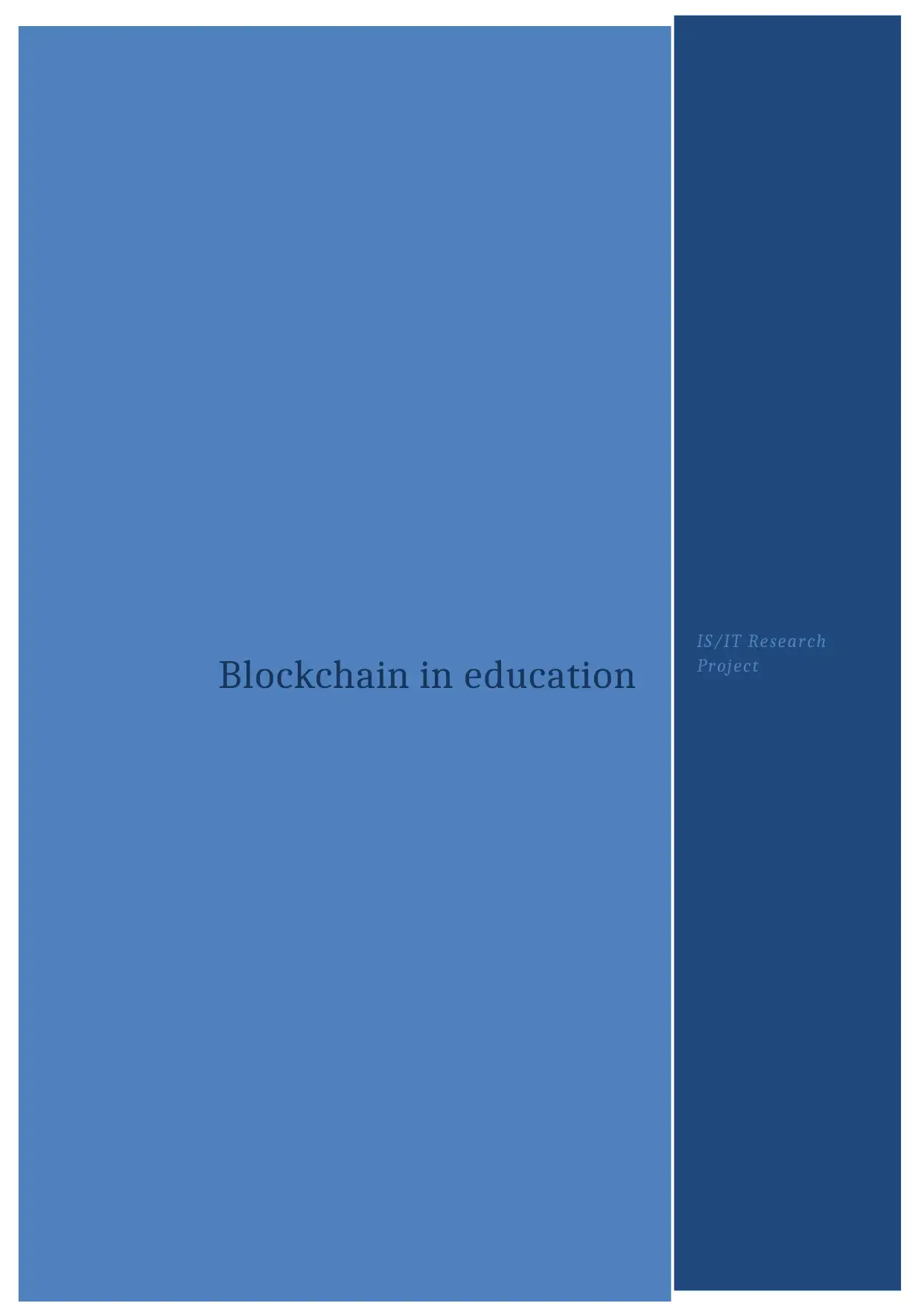
Blockchain in education
IS/IT Research
Project
IS/IT Research
Project
Paraphrase This Document
Need a fresh take? Get an instant paraphrase of this document with our AI Paraphraser
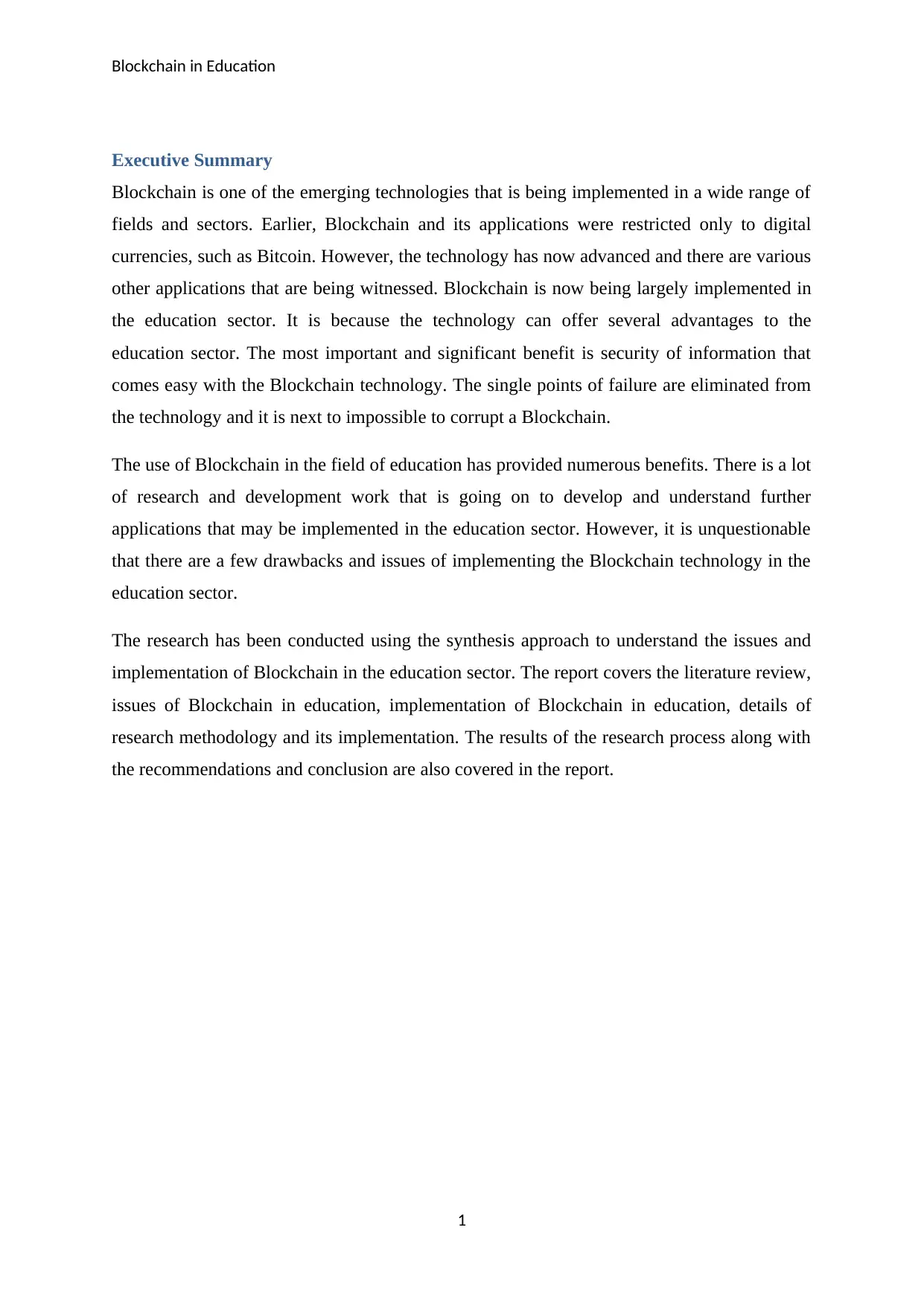
Blockchain in Education
Executive Summary
Blockchain is one of the emerging technologies that is being implemented in a wide range of
fields and sectors. Earlier, Blockchain and its applications were restricted only to digital
currencies, such as Bitcoin. However, the technology has now advanced and there are various
other applications that are being witnessed. Blockchain is now being largely implemented in
the education sector. It is because the technology can offer several advantages to the
education sector. The most important and significant benefit is security of information that
comes easy with the Blockchain technology. The single points of failure are eliminated from
the technology and it is next to impossible to corrupt a Blockchain.
The use of Blockchain in the field of education has provided numerous benefits. There is a lot
of research and development work that is going on to develop and understand further
applications that may be implemented in the education sector. However, it is unquestionable
that there are a few drawbacks and issues of implementing the Blockchain technology in the
education sector.
The research has been conducted using the synthesis approach to understand the issues and
implementation of Blockchain in the education sector. The report covers the literature review,
issues of Blockchain in education, implementation of Blockchain in education, details of
research methodology and its implementation. The results of the research process along with
the recommendations and conclusion are also covered in the report.
1
Executive Summary
Blockchain is one of the emerging technologies that is being implemented in a wide range of
fields and sectors. Earlier, Blockchain and its applications were restricted only to digital
currencies, such as Bitcoin. However, the technology has now advanced and there are various
other applications that are being witnessed. Blockchain is now being largely implemented in
the education sector. It is because the technology can offer several advantages to the
education sector. The most important and significant benefit is security of information that
comes easy with the Blockchain technology. The single points of failure are eliminated from
the technology and it is next to impossible to corrupt a Blockchain.
The use of Blockchain in the field of education has provided numerous benefits. There is a lot
of research and development work that is going on to develop and understand further
applications that may be implemented in the education sector. However, it is unquestionable
that there are a few drawbacks and issues of implementing the Blockchain technology in the
education sector.
The research has been conducted using the synthesis approach to understand the issues and
implementation of Blockchain in the education sector. The report covers the literature review,
issues of Blockchain in education, implementation of Blockchain in education, details of
research methodology and its implementation. The results of the research process along with
the recommendations and conclusion are also covered in the report.
1
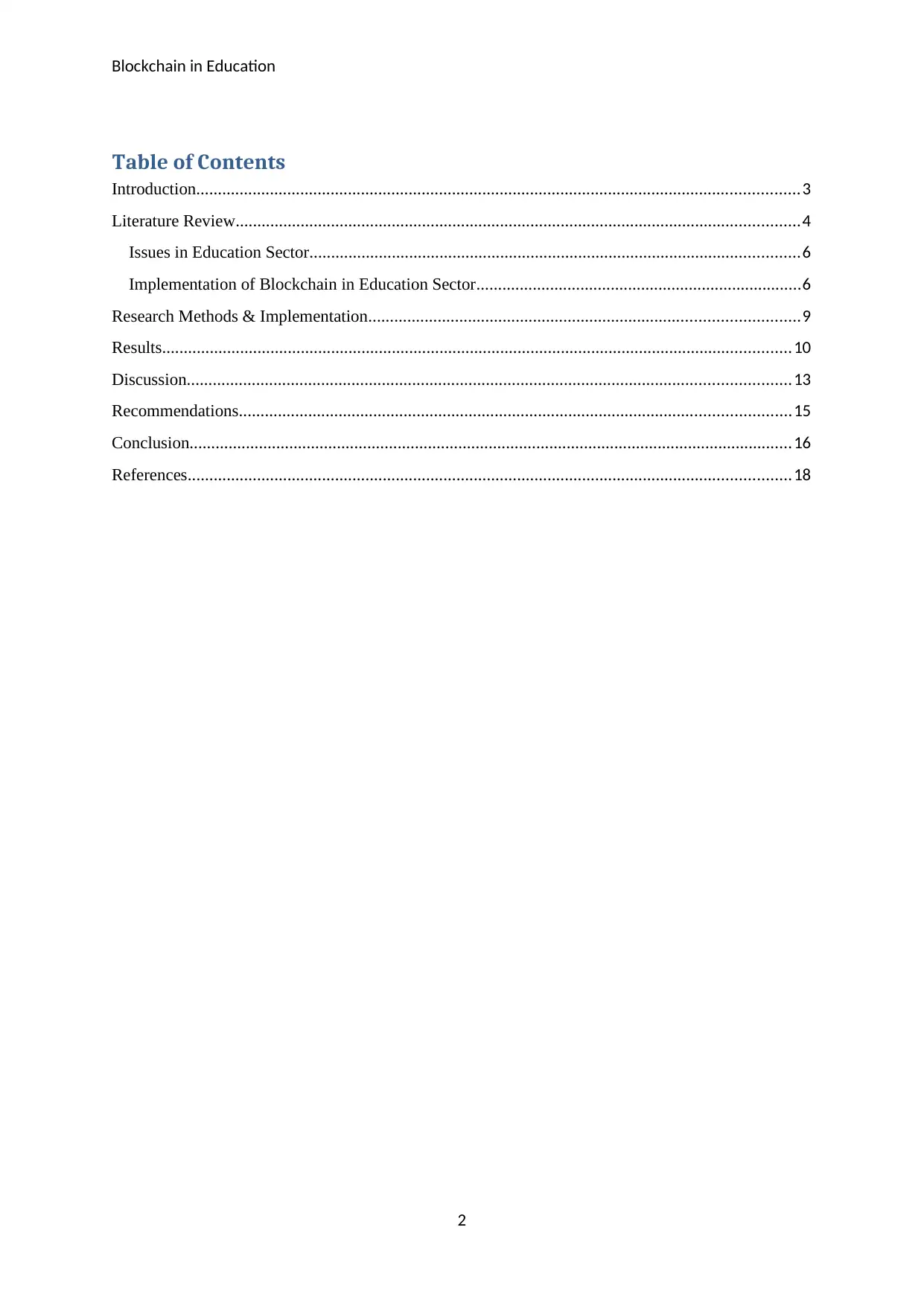
Blockchain in Education
Table of Contents
Introduction...........................................................................................................................................3
Literature Review..................................................................................................................................4
Issues in Education Sector.................................................................................................................6
Implementation of Blockchain in Education Sector...........................................................................6
Research Methods & Implementation...................................................................................................9
Results.................................................................................................................................................10
Discussion...........................................................................................................................................13
Recommendations...............................................................................................................................15
Conclusion...........................................................................................................................................16
References...........................................................................................................................................18
2
Table of Contents
Introduction...........................................................................................................................................3
Literature Review..................................................................................................................................4
Issues in Education Sector.................................................................................................................6
Implementation of Blockchain in Education Sector...........................................................................6
Research Methods & Implementation...................................................................................................9
Results.................................................................................................................................................10
Discussion...........................................................................................................................................13
Recommendations...............................................................................................................................15
Conclusion...........................................................................................................................................16
References...........................................................................................................................................18
2
⊘ This is a preview!⊘
Do you want full access?
Subscribe today to unlock all pages.

Trusted by 1+ million students worldwide
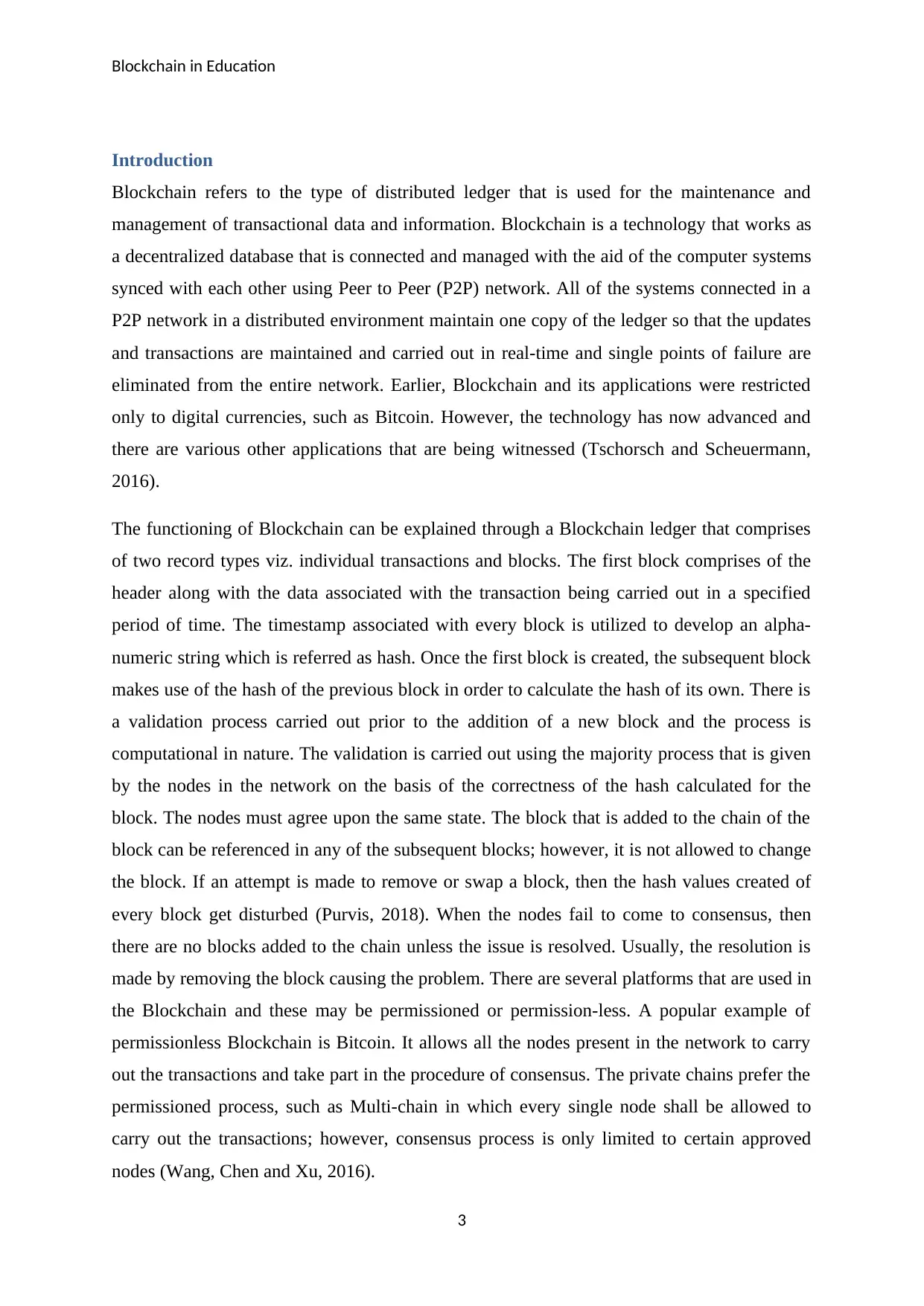
Blockchain in Education
Introduction
Blockchain refers to the type of distributed ledger that is used for the maintenance and
management of transactional data and information. Blockchain is a technology that works as
a decentralized database that is connected and managed with the aid of the computer systems
synced with each other using Peer to Peer (P2P) network. All of the systems connected in a
P2P network in a distributed environment maintain one copy of the ledger so that the updates
and transactions are maintained and carried out in real-time and single points of failure are
eliminated from the entire network. Earlier, Blockchain and its applications were restricted
only to digital currencies, such as Bitcoin. However, the technology has now advanced and
there are various other applications that are being witnessed (Tschorsch and Scheuermann,
2016).
The functioning of Blockchain can be explained through a Blockchain ledger that comprises
of two record types viz. individual transactions and blocks. The first block comprises of the
header along with the data associated with the transaction being carried out in a specified
period of time. The timestamp associated with every block is utilized to develop an alpha-
numeric string which is referred as hash. Once the first block is created, the subsequent block
makes use of the hash of the previous block in order to calculate the hash of its own. There is
a validation process carried out prior to the addition of a new block and the process is
computational in nature. The validation is carried out using the majority process that is given
by the nodes in the network on the basis of the correctness of the hash calculated for the
block. The nodes must agree upon the same state. The block that is added to the chain of the
block can be referenced in any of the subsequent blocks; however, it is not allowed to change
the block. If an attempt is made to remove or swap a block, then the hash values created of
every block get disturbed (Purvis, 2018). When the nodes fail to come to consensus, then
there are no blocks added to the chain unless the issue is resolved. Usually, the resolution is
made by removing the block causing the problem. There are several platforms that are used in
the Blockchain and these may be permissioned or permission-less. A popular example of
permissionless Blockchain is Bitcoin. It allows all the nodes present in the network to carry
out the transactions and take part in the procedure of consensus. The private chains prefer the
permissioned process, such as Multi-chain in which every single node shall be allowed to
carry out the transactions; however, consensus process is only limited to certain approved
nodes (Wang, Chen and Xu, 2016).
3
Introduction
Blockchain refers to the type of distributed ledger that is used for the maintenance and
management of transactional data and information. Blockchain is a technology that works as
a decentralized database that is connected and managed with the aid of the computer systems
synced with each other using Peer to Peer (P2P) network. All of the systems connected in a
P2P network in a distributed environment maintain one copy of the ledger so that the updates
and transactions are maintained and carried out in real-time and single points of failure are
eliminated from the entire network. Earlier, Blockchain and its applications were restricted
only to digital currencies, such as Bitcoin. However, the technology has now advanced and
there are various other applications that are being witnessed (Tschorsch and Scheuermann,
2016).
The functioning of Blockchain can be explained through a Blockchain ledger that comprises
of two record types viz. individual transactions and blocks. The first block comprises of the
header along with the data associated with the transaction being carried out in a specified
period of time. The timestamp associated with every block is utilized to develop an alpha-
numeric string which is referred as hash. Once the first block is created, the subsequent block
makes use of the hash of the previous block in order to calculate the hash of its own. There is
a validation process carried out prior to the addition of a new block and the process is
computational in nature. The validation is carried out using the majority process that is given
by the nodes in the network on the basis of the correctness of the hash calculated for the
block. The nodes must agree upon the same state. The block that is added to the chain of the
block can be referenced in any of the subsequent blocks; however, it is not allowed to change
the block. If an attempt is made to remove or swap a block, then the hash values created of
every block get disturbed (Purvis, 2018). When the nodes fail to come to consensus, then
there are no blocks added to the chain unless the issue is resolved. Usually, the resolution is
made by removing the block causing the problem. There are several platforms that are used in
the Blockchain and these may be permissioned or permission-less. A popular example of
permissionless Blockchain is Bitcoin. It allows all the nodes present in the network to carry
out the transactions and take part in the procedure of consensus. The private chains prefer the
permissioned process, such as Multi-chain in which every single node shall be allowed to
carry out the transactions; however, consensus process is only limited to certain approved
nodes (Wang, Chen and Xu, 2016).
3
Paraphrase This Document
Need a fresh take? Get an instant paraphrase of this document with our AI Paraphraser
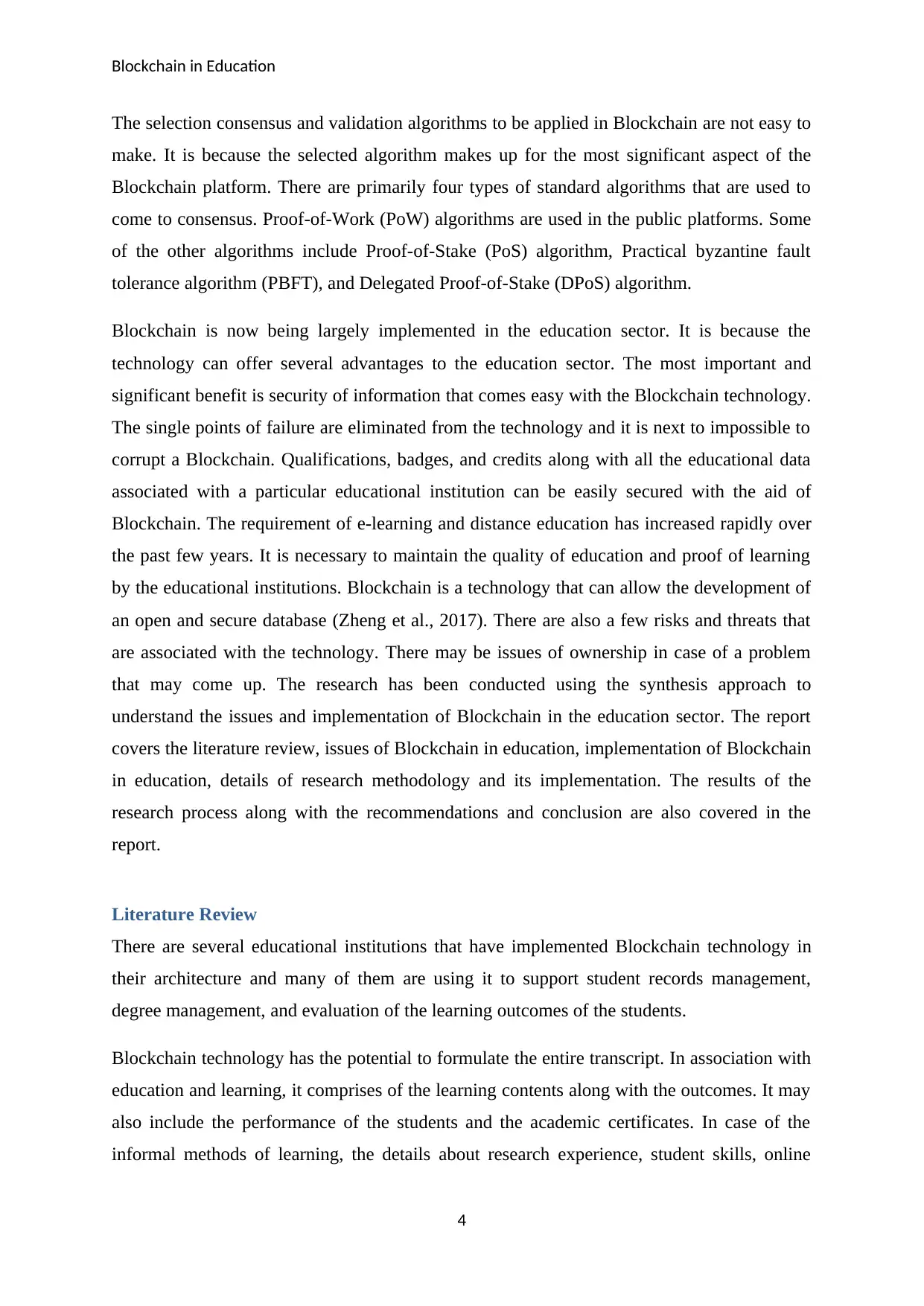
Blockchain in Education
The selection consensus and validation algorithms to be applied in Blockchain are not easy to
make. It is because the selected algorithm makes up for the most significant aspect of the
Blockchain platform. There are primarily four types of standard algorithms that are used to
come to consensus. Proof-of-Work (PoW) algorithms are used in the public platforms. Some
of the other algorithms include Proof-of-Stake (PoS) algorithm, Practical byzantine fault
tolerance algorithm (PBFT), and Delegated Proof-of-Stake (DPoS) algorithm.
Blockchain is now being largely implemented in the education sector. It is because the
technology can offer several advantages to the education sector. The most important and
significant benefit is security of information that comes easy with the Blockchain technology.
The single points of failure are eliminated from the technology and it is next to impossible to
corrupt a Blockchain. Qualifications, badges, and credits along with all the educational data
associated with a particular educational institution can be easily secured with the aid of
Blockchain. The requirement of e-learning and distance education has increased rapidly over
the past few years. It is necessary to maintain the quality of education and proof of learning
by the educational institutions. Blockchain is a technology that can allow the development of
an open and secure database (Zheng et al., 2017). There are also a few risks and threats that
are associated with the technology. There may be issues of ownership in case of a problem
that may come up. The research has been conducted using the synthesis approach to
understand the issues and implementation of Blockchain in the education sector. The report
covers the literature review, issues of Blockchain in education, implementation of Blockchain
in education, details of research methodology and its implementation. The results of the
research process along with the recommendations and conclusion are also covered in the
report.
Literature Review
There are several educational institutions that have implemented Blockchain technology in
their architecture and many of them are using it to support student records management,
degree management, and evaluation of the learning outcomes of the students.
Blockchain technology has the potential to formulate the entire transcript. In association with
education and learning, it comprises of the learning contents along with the outcomes. It may
also include the performance of the students and the academic certificates. In case of the
informal methods of learning, the details about research experience, student skills, online
4
The selection consensus and validation algorithms to be applied in Blockchain are not easy to
make. It is because the selected algorithm makes up for the most significant aspect of the
Blockchain platform. There are primarily four types of standard algorithms that are used to
come to consensus. Proof-of-Work (PoW) algorithms are used in the public platforms. Some
of the other algorithms include Proof-of-Stake (PoS) algorithm, Practical byzantine fault
tolerance algorithm (PBFT), and Delegated Proof-of-Stake (DPoS) algorithm.
Blockchain is now being largely implemented in the education sector. It is because the
technology can offer several advantages to the education sector. The most important and
significant benefit is security of information that comes easy with the Blockchain technology.
The single points of failure are eliminated from the technology and it is next to impossible to
corrupt a Blockchain. Qualifications, badges, and credits along with all the educational data
associated with a particular educational institution can be easily secured with the aid of
Blockchain. The requirement of e-learning and distance education has increased rapidly over
the past few years. It is necessary to maintain the quality of education and proof of learning
by the educational institutions. Blockchain is a technology that can allow the development of
an open and secure database (Zheng et al., 2017). There are also a few risks and threats that
are associated with the technology. There may be issues of ownership in case of a problem
that may come up. The research has been conducted using the synthesis approach to
understand the issues and implementation of Blockchain in the education sector. The report
covers the literature review, issues of Blockchain in education, implementation of Blockchain
in education, details of research methodology and its implementation. The results of the
research process along with the recommendations and conclusion are also covered in the
report.
Literature Review
There are several educational institutions that have implemented Blockchain technology in
their architecture and many of them are using it to support student records management,
degree management, and evaluation of the learning outcomes of the students.
Blockchain technology has the potential to formulate the entire transcript. In association with
education and learning, it comprises of the learning contents along with the outcomes. It may
also include the performance of the students and the academic certificates. In case of the
informal methods of learning, the details about research experience, student skills, online
4
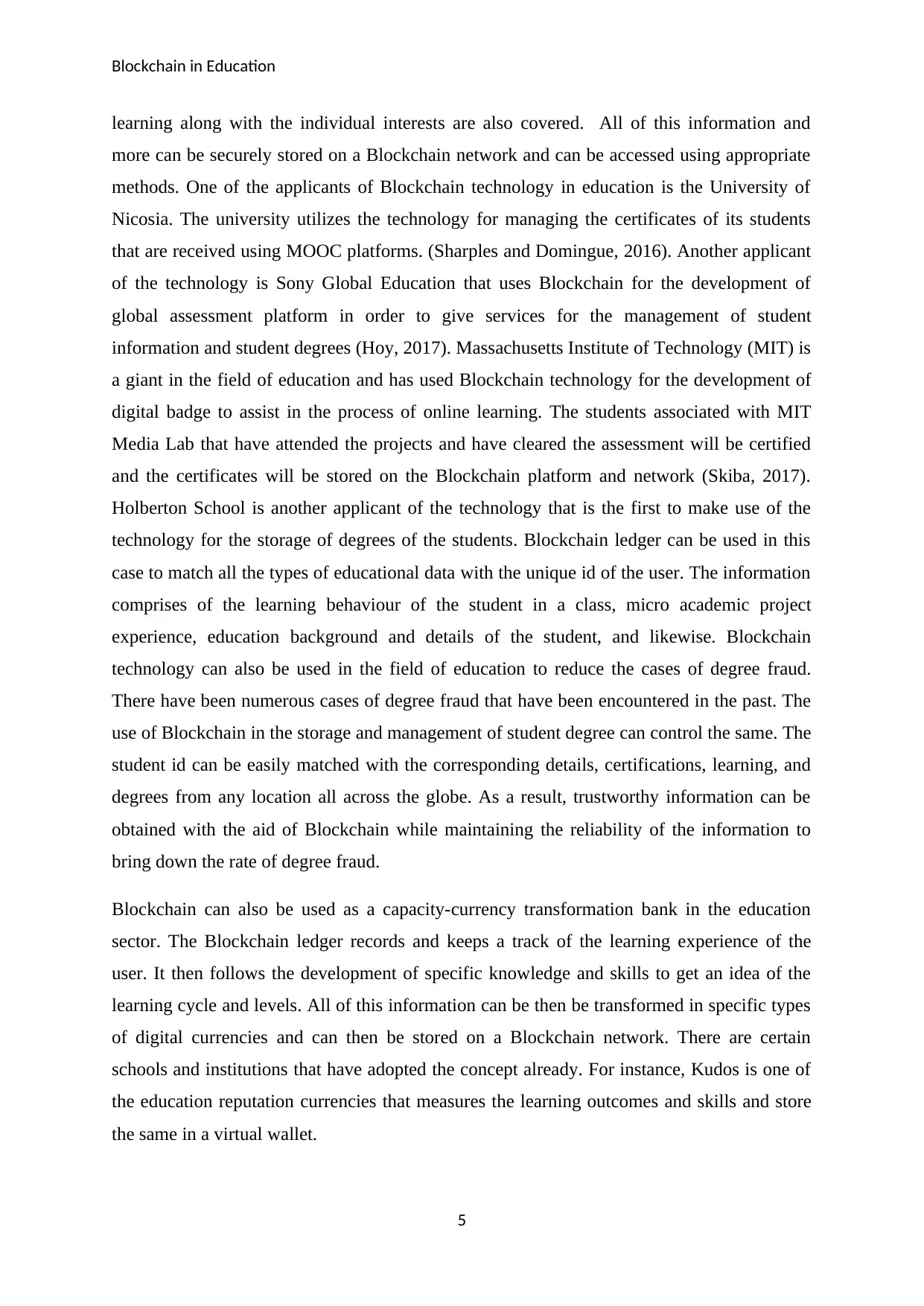
Blockchain in Education
learning along with the individual interests are also covered. All of this information and
more can be securely stored on a Blockchain network and can be accessed using appropriate
methods. One of the applicants of Blockchain technology in education is the University of
Nicosia. The university utilizes the technology for managing the certificates of its students
that are received using MOOC platforms. (Sharples and Domingue, 2016). Another applicant
of the technology is Sony Global Education that uses Blockchain for the development of
global assessment platform in order to give services for the management of student
information and student degrees (Hoy, 2017). Massachusetts Institute of Technology (MIT) is
a giant in the field of education and has used Blockchain technology for the development of
digital badge to assist in the process of online learning. The students associated with MIT
Media Lab that have attended the projects and have cleared the assessment will be certified
and the certificates will be stored on the Blockchain platform and network (Skiba, 2017).
Holberton School is another applicant of the technology that is the first to make use of the
technology for the storage of degrees of the students. Blockchain ledger can be used in this
case to match all the types of educational data with the unique id of the user. The information
comprises of the learning behaviour of the student in a class, micro academic project
experience, education background and details of the student, and likewise. Blockchain
technology can also be used in the field of education to reduce the cases of degree fraud.
There have been numerous cases of degree fraud that have been encountered in the past. The
use of Blockchain in the storage and management of student degree can control the same. The
student id can be easily matched with the corresponding details, certifications, learning, and
degrees from any location all across the globe. As a result, trustworthy information can be
obtained with the aid of Blockchain while maintaining the reliability of the information to
bring down the rate of degree fraud.
Blockchain can also be used as a capacity-currency transformation bank in the education
sector. The Blockchain ledger records and keeps a track of the learning experience of the
user. It then follows the development of specific knowledge and skills to get an idea of the
learning cycle and levels. All of this information can be then be transformed in specific types
of digital currencies and can then be stored on a Blockchain network. There are certain
schools and institutions that have adopted the concept already. For instance, Kudos is one of
the education reputation currencies that measures the learning outcomes and skills and store
the same in a virtual wallet.
5
learning along with the individual interests are also covered. All of this information and
more can be securely stored on a Blockchain network and can be accessed using appropriate
methods. One of the applicants of Blockchain technology in education is the University of
Nicosia. The university utilizes the technology for managing the certificates of its students
that are received using MOOC platforms. (Sharples and Domingue, 2016). Another applicant
of the technology is Sony Global Education that uses Blockchain for the development of
global assessment platform in order to give services for the management of student
information and student degrees (Hoy, 2017). Massachusetts Institute of Technology (MIT) is
a giant in the field of education and has used Blockchain technology for the development of
digital badge to assist in the process of online learning. The students associated with MIT
Media Lab that have attended the projects and have cleared the assessment will be certified
and the certificates will be stored on the Blockchain platform and network (Skiba, 2017).
Holberton School is another applicant of the technology that is the first to make use of the
technology for the storage of degrees of the students. Blockchain ledger can be used in this
case to match all the types of educational data with the unique id of the user. The information
comprises of the learning behaviour of the student in a class, micro academic project
experience, education background and details of the student, and likewise. Blockchain
technology can also be used in the field of education to reduce the cases of degree fraud.
There have been numerous cases of degree fraud that have been encountered in the past. The
use of Blockchain in the storage and management of student degree can control the same. The
student id can be easily matched with the corresponding details, certifications, learning, and
degrees from any location all across the globe. As a result, trustworthy information can be
obtained with the aid of Blockchain while maintaining the reliability of the information to
bring down the rate of degree fraud.
Blockchain can also be used as a capacity-currency transformation bank in the education
sector. The Blockchain ledger records and keeps a track of the learning experience of the
user. It then follows the development of specific knowledge and skills to get an idea of the
learning cycle and levels. All of this information can be then be transformed in specific types
of digital currencies and can then be stored on a Blockchain network. There are certain
schools and institutions that have adopted the concept already. For instance, Kudos is one of
the education reputation currencies that measures the learning outcomes and skills and store
the same in a virtual wallet.
5
⊘ This is a preview!⊘
Do you want full access?
Subscribe today to unlock all pages.

Trusted by 1+ million students worldwide
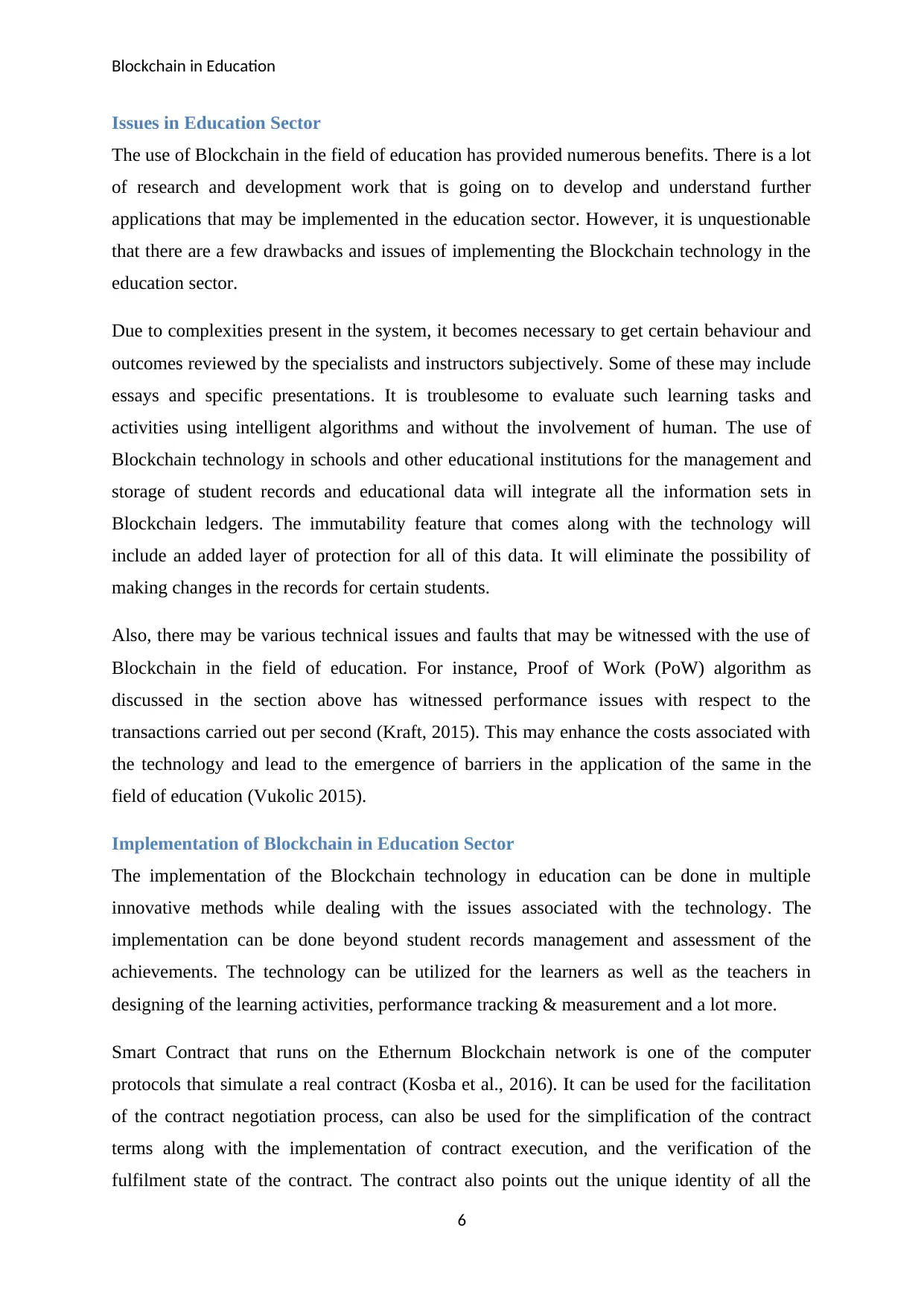
Blockchain in Education
Issues in Education Sector
The use of Blockchain in the field of education has provided numerous benefits. There is a lot
of research and development work that is going on to develop and understand further
applications that may be implemented in the education sector. However, it is unquestionable
that there are a few drawbacks and issues of implementing the Blockchain technology in the
education sector.
Due to complexities present in the system, it becomes necessary to get certain behaviour and
outcomes reviewed by the specialists and instructors subjectively. Some of these may include
essays and specific presentations. It is troublesome to evaluate such learning tasks and
activities using intelligent algorithms and without the involvement of human. The use of
Blockchain technology in schools and other educational institutions for the management and
storage of student records and educational data will integrate all the information sets in
Blockchain ledgers. The immutability feature that comes along with the technology will
include an added layer of protection for all of this data. It will eliminate the possibility of
making changes in the records for certain students.
Also, there may be various technical issues and faults that may be witnessed with the use of
Blockchain in the field of education. For instance, Proof of Work (PoW) algorithm as
discussed in the section above has witnessed performance issues with respect to the
transactions carried out per second (Kraft, 2015). This may enhance the costs associated with
the technology and lead to the emergence of barriers in the application of the same in the
field of education (Vukolic 2015).
Implementation of Blockchain in Education Sector
The implementation of the Blockchain technology in education can be done in multiple
innovative methods while dealing with the issues associated with the technology. The
implementation can be done beyond student records management and assessment of the
achievements. The technology can be utilized for the learners as well as the teachers in
designing of the learning activities, performance tracking & measurement and a lot more.
Smart Contract that runs on the Ethernum Blockchain network is one of the computer
protocols that simulate a real contract (Kosba et al., 2016). It can be used for the facilitation
of the contract negotiation process, can also be used for the simplification of the contract
terms along with the implementation of contract execution, and the verification of the
fulfilment state of the contract. The contract also points out the unique identity of all the
6
Issues in Education Sector
The use of Blockchain in the field of education has provided numerous benefits. There is a lot
of research and development work that is going on to develop and understand further
applications that may be implemented in the education sector. However, it is unquestionable
that there are a few drawbacks and issues of implementing the Blockchain technology in the
education sector.
Due to complexities present in the system, it becomes necessary to get certain behaviour and
outcomes reviewed by the specialists and instructors subjectively. Some of these may include
essays and specific presentations. It is troublesome to evaluate such learning tasks and
activities using intelligent algorithms and without the involvement of human. The use of
Blockchain technology in schools and other educational institutions for the management and
storage of student records and educational data will integrate all the information sets in
Blockchain ledgers. The immutability feature that comes along with the technology will
include an added layer of protection for all of this data. It will eliminate the possibility of
making changes in the records for certain students.
Also, there may be various technical issues and faults that may be witnessed with the use of
Blockchain in the field of education. For instance, Proof of Work (PoW) algorithm as
discussed in the section above has witnessed performance issues with respect to the
transactions carried out per second (Kraft, 2015). This may enhance the costs associated with
the technology and lead to the emergence of barriers in the application of the same in the
field of education (Vukolic 2015).
Implementation of Blockchain in Education Sector
The implementation of the Blockchain technology in education can be done in multiple
innovative methods while dealing with the issues associated with the technology. The
implementation can be done beyond student records management and assessment of the
achievements. The technology can be utilized for the learners as well as the teachers in
designing of the learning activities, performance tracking & measurement and a lot more.
Smart Contract that runs on the Ethernum Blockchain network is one of the computer
protocols that simulate a real contract (Kosba et al., 2016). It can be used for the facilitation
of the contract negotiation process, can also be used for the simplification of the contract
terms along with the implementation of contract execution, and the verification of the
fulfilment state of the contract. The contract also points out the unique identity of all the
6
Paraphrase This Document
Need a fresh take? Get an instant paraphrase of this document with our AI Paraphraser
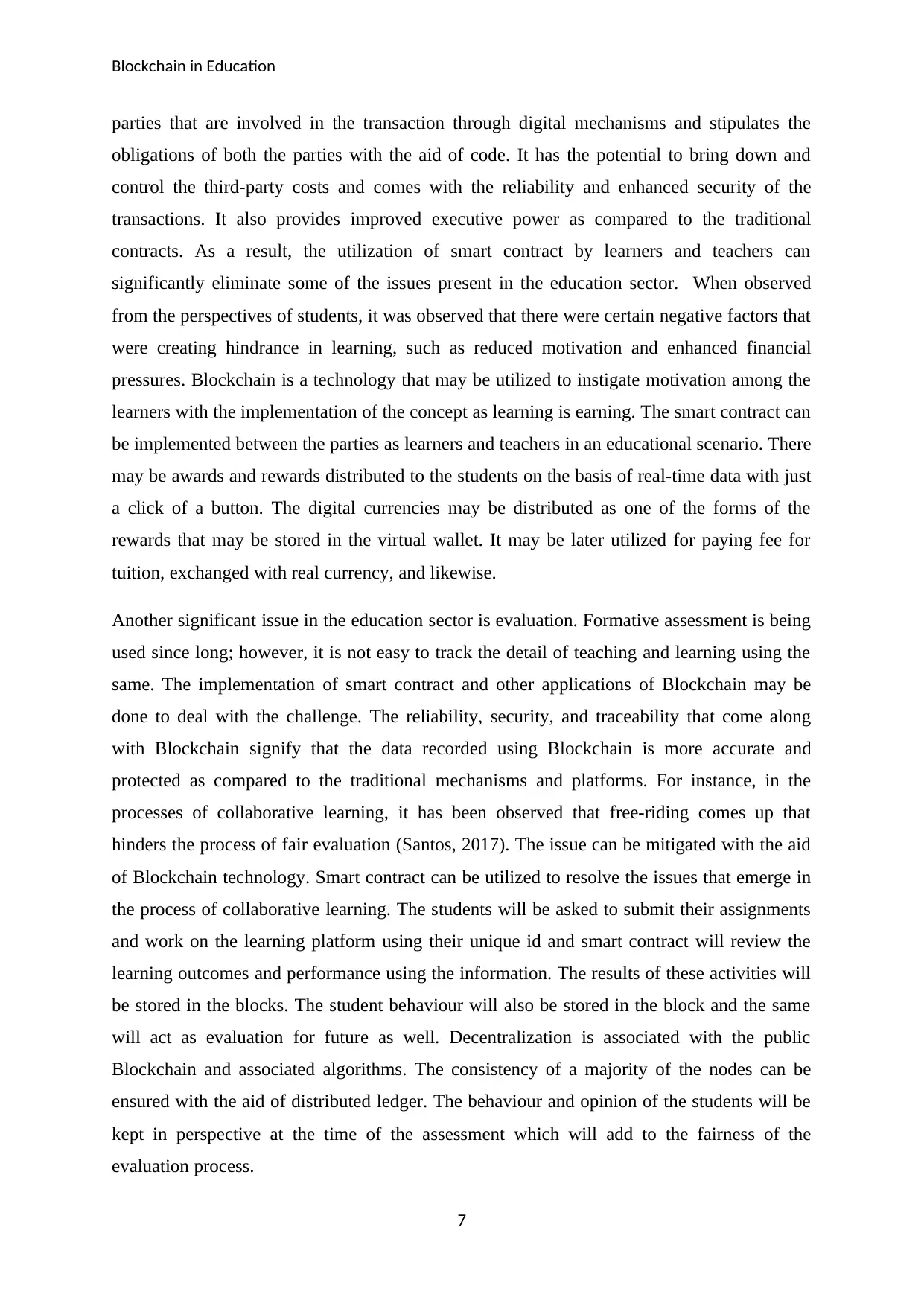
Blockchain in Education
parties that are involved in the transaction through digital mechanisms and stipulates the
obligations of both the parties with the aid of code. It has the potential to bring down and
control the third-party costs and comes with the reliability and enhanced security of the
transactions. It also provides improved executive power as compared to the traditional
contracts. As a result, the utilization of smart contract by learners and teachers can
significantly eliminate some of the issues present in the education sector. When observed
from the perspectives of students, it was observed that there were certain negative factors that
were creating hindrance in learning, such as reduced motivation and enhanced financial
pressures. Blockchain is a technology that may be utilized to instigate motivation among the
learners with the implementation of the concept as learning is earning. The smart contract can
be implemented between the parties as learners and teachers in an educational scenario. There
may be awards and rewards distributed to the students on the basis of real-time data with just
a click of a button. The digital currencies may be distributed as one of the forms of the
rewards that may be stored in the virtual wallet. It may be later utilized for paying fee for
tuition, exchanged with real currency, and likewise.
Another significant issue in the education sector is evaluation. Formative assessment is being
used since long; however, it is not easy to track the detail of teaching and learning using the
same. The implementation of smart contract and other applications of Blockchain may be
done to deal with the challenge. The reliability, security, and traceability that come along
with Blockchain signify that the data recorded using Blockchain is more accurate and
protected as compared to the traditional mechanisms and platforms. For instance, in the
processes of collaborative learning, it has been observed that free-riding comes up that
hinders the process of fair evaluation (Santos, 2017). The issue can be mitigated with the aid
of Blockchain technology. Smart contract can be utilized to resolve the issues that emerge in
the process of collaborative learning. The students will be asked to submit their assignments
and work on the learning platform using their unique id and smart contract will review the
learning outcomes and performance using the information. The results of these activities will
be stored in the blocks. The student behaviour will also be stored in the block and the same
will act as evaluation for future as well. Decentralization is associated with the public
Blockchain and associated algorithms. The consistency of a majority of the nodes can be
ensured with the aid of distributed ledger. The behaviour and opinion of the students will be
kept in perspective at the time of the assessment which will add to the fairness of the
evaluation process.
7
parties that are involved in the transaction through digital mechanisms and stipulates the
obligations of both the parties with the aid of code. It has the potential to bring down and
control the third-party costs and comes with the reliability and enhanced security of the
transactions. It also provides improved executive power as compared to the traditional
contracts. As a result, the utilization of smart contract by learners and teachers can
significantly eliminate some of the issues present in the education sector. When observed
from the perspectives of students, it was observed that there were certain negative factors that
were creating hindrance in learning, such as reduced motivation and enhanced financial
pressures. Blockchain is a technology that may be utilized to instigate motivation among the
learners with the implementation of the concept as learning is earning. The smart contract can
be implemented between the parties as learners and teachers in an educational scenario. There
may be awards and rewards distributed to the students on the basis of real-time data with just
a click of a button. The digital currencies may be distributed as one of the forms of the
rewards that may be stored in the virtual wallet. It may be later utilized for paying fee for
tuition, exchanged with real currency, and likewise.
Another significant issue in the education sector is evaluation. Formative assessment is being
used since long; however, it is not easy to track the detail of teaching and learning using the
same. The implementation of smart contract and other applications of Blockchain may be
done to deal with the challenge. The reliability, security, and traceability that come along
with Blockchain signify that the data recorded using Blockchain is more accurate and
protected as compared to the traditional mechanisms and platforms. For instance, in the
processes of collaborative learning, it has been observed that free-riding comes up that
hinders the process of fair evaluation (Santos, 2017). The issue can be mitigated with the aid
of Blockchain technology. Smart contract can be utilized to resolve the issues that emerge in
the process of collaborative learning. The students will be asked to submit their assignments
and work on the learning platform using their unique id and smart contract will review the
learning outcomes and performance using the information. The results of these activities will
be stored in the blocks. The student behaviour will also be stored in the block and the same
will act as evaluation for future as well. Decentralization is associated with the public
Blockchain and associated algorithms. The consistency of a majority of the nodes can be
ensured with the aid of distributed ledger. The behaviour and opinion of the students will be
kept in perspective at the time of the assessment which will add to the fairness of the
evaluation process.
7
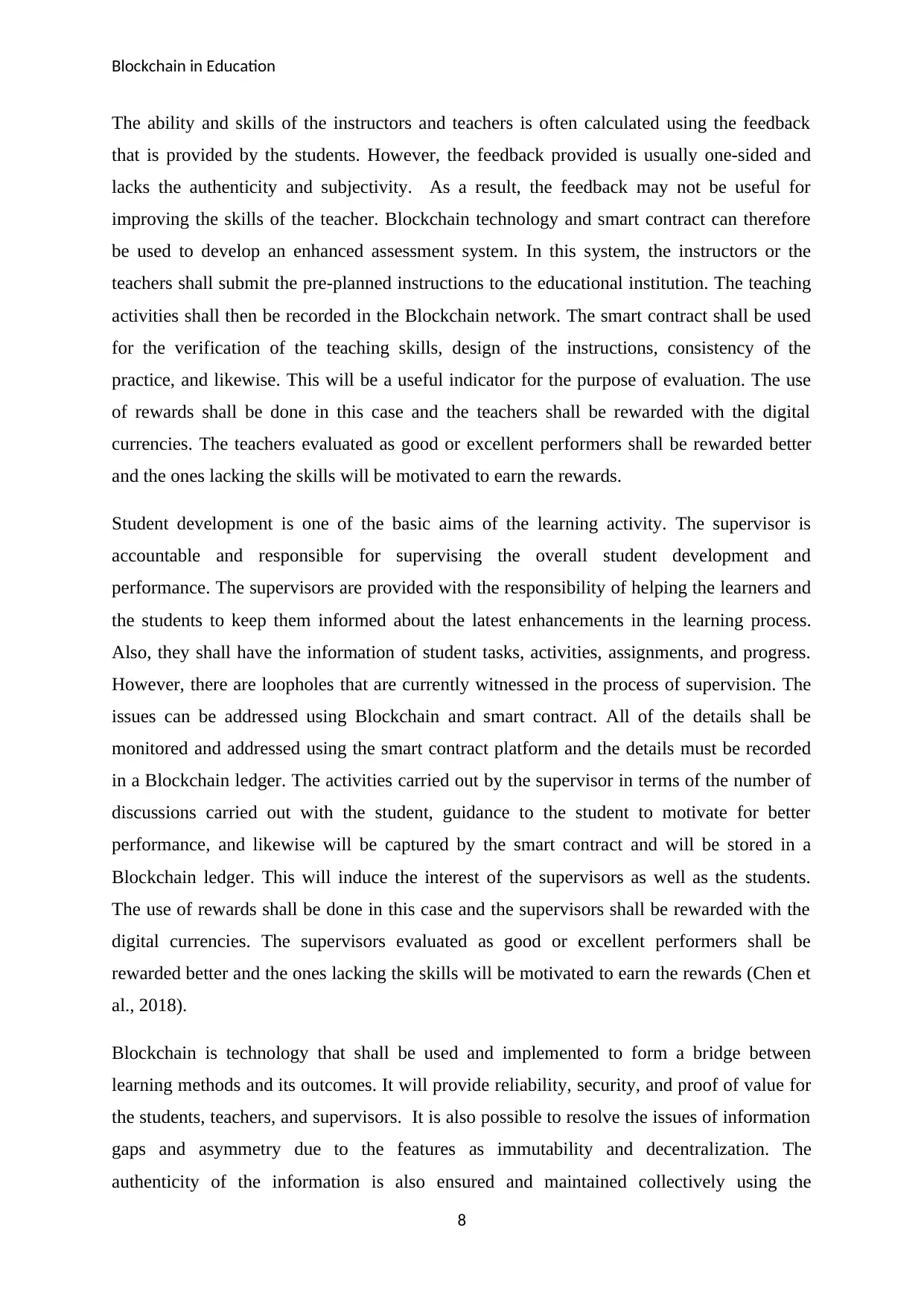
Blockchain in Education
The ability and skills of the instructors and teachers is often calculated using the feedback
that is provided by the students. However, the feedback provided is usually one-sided and
lacks the authenticity and subjectivity. As a result, the feedback may not be useful for
improving the skills of the teacher. Blockchain technology and smart contract can therefore
be used to develop an enhanced assessment system. In this system, the instructors or the
teachers shall submit the pre-planned instructions to the educational institution. The teaching
activities shall then be recorded in the Blockchain network. The smart contract shall be used
for the verification of the teaching skills, design of the instructions, consistency of the
practice, and likewise. This will be a useful indicator for the purpose of evaluation. The use
of rewards shall be done in this case and the teachers shall be rewarded with the digital
currencies. The teachers evaluated as good or excellent performers shall be rewarded better
and the ones lacking the skills will be motivated to earn the rewards.
Student development is one of the basic aims of the learning activity. The supervisor is
accountable and responsible for supervising the overall student development and
performance. The supervisors are provided with the responsibility of helping the learners and
the students to keep them informed about the latest enhancements in the learning process.
Also, they shall have the information of student tasks, activities, assignments, and progress.
However, there are loopholes that are currently witnessed in the process of supervision. The
issues can be addressed using Blockchain and smart contract. All of the details shall be
monitored and addressed using the smart contract platform and the details must be recorded
in a Blockchain ledger. The activities carried out by the supervisor in terms of the number of
discussions carried out with the student, guidance to the student to motivate for better
performance, and likewise will be captured by the smart contract and will be stored in a
Blockchain ledger. This will induce the interest of the supervisors as well as the students.
The use of rewards shall be done in this case and the supervisors shall be rewarded with the
digital currencies. The supervisors evaluated as good or excellent performers shall be
rewarded better and the ones lacking the skills will be motivated to earn the rewards (Chen et
al., 2018).
Blockchain is technology that shall be used and implemented to form a bridge between
learning methods and its outcomes. It will provide reliability, security, and proof of value for
the students, teachers, and supervisors. It is also possible to resolve the issues of information
gaps and asymmetry due to the features as immutability and decentralization. The
authenticity of the information is also ensured and maintained collectively using the
8
The ability and skills of the instructors and teachers is often calculated using the feedback
that is provided by the students. However, the feedback provided is usually one-sided and
lacks the authenticity and subjectivity. As a result, the feedback may not be useful for
improving the skills of the teacher. Blockchain technology and smart contract can therefore
be used to develop an enhanced assessment system. In this system, the instructors or the
teachers shall submit the pre-planned instructions to the educational institution. The teaching
activities shall then be recorded in the Blockchain network. The smart contract shall be used
for the verification of the teaching skills, design of the instructions, consistency of the
practice, and likewise. This will be a useful indicator for the purpose of evaluation. The use
of rewards shall be done in this case and the teachers shall be rewarded with the digital
currencies. The teachers evaluated as good or excellent performers shall be rewarded better
and the ones lacking the skills will be motivated to earn the rewards.
Student development is one of the basic aims of the learning activity. The supervisor is
accountable and responsible for supervising the overall student development and
performance. The supervisors are provided with the responsibility of helping the learners and
the students to keep them informed about the latest enhancements in the learning process.
Also, they shall have the information of student tasks, activities, assignments, and progress.
However, there are loopholes that are currently witnessed in the process of supervision. The
issues can be addressed using Blockchain and smart contract. All of the details shall be
monitored and addressed using the smart contract platform and the details must be recorded
in a Blockchain ledger. The activities carried out by the supervisor in terms of the number of
discussions carried out with the student, guidance to the student to motivate for better
performance, and likewise will be captured by the smart contract and will be stored in a
Blockchain ledger. This will induce the interest of the supervisors as well as the students.
The use of rewards shall be done in this case and the supervisors shall be rewarded with the
digital currencies. The supervisors evaluated as good or excellent performers shall be
rewarded better and the ones lacking the skills will be motivated to earn the rewards (Chen et
al., 2018).
Blockchain is technology that shall be used and implemented to form a bridge between
learning methods and its outcomes. It will provide reliability, security, and proof of value for
the students, teachers, and supervisors. It is also possible to resolve the issues of information
gaps and asymmetry due to the features as immutability and decentralization. The
authenticity of the information is also ensured and maintained collectively using the
8
⊘ This is a preview!⊘
Do you want full access?
Subscribe today to unlock all pages.

Trusted by 1+ million students worldwide

Blockchain in Education
technology and its associated applications. The implementation of Blockchain and the use of
digital currencies can act as catalysts for motivating the students, teachers, and supervisors.
Research Methods & Implementation
The methodology that has been used for the research work is the synthesis approach along
with the use of inductive inquiry and hypothesis-driven research. An exploratory research
mechanism has been followed to analyse and understand the research done by the researchers
in the past and to integrate the facts to provide the answers to the research questions and
achieve the objectives of the research. There is also close observation that has been done on
the academic journals and research papers published on the topic as Blockchain, its potential
applications, benefits & drawbacks, and the implementation of the technology in the field of
education. The synthesis approach is used to collect the information from varied sources of
data. Blockchain is one of the emerging technologies and there is a lot of research work that
is being done in the field. There are advancements that are being made in Blockchain with
each passing day. The use of qualitative methods will lead to the generation of practical
approach for carrying out the research work (Thompson et al., 2015).
The research methodology as synthesis approach will assist in the process of conquering
qualitative data and information sets obtained from the researchers working on the topic as
Blockchain technology and its implementation in the education sector. There are several
qualitative methods that have been used for the purpose of data gathering. Some of these
methods include domain analysis, observation, interviews, groups discussions, and
brainstorming sessions.
The primary aim of the usage of synthesis approach in the research work is to obtain the
answers from the research papers and journal articles. The methodology will be applied in
this case to provide the answers to the questions as listed below:
What are the applications and issues of Blockchain technology in the student records
management process?
What is the applicability of Blockchain in education and the current status?
What are the loopholes present in the process of authorization and certification that
may be resolved using Blockchain?
Will Blockchain be helpful in controlling degree fraud?
9
technology and its associated applications. The implementation of Blockchain and the use of
digital currencies can act as catalysts for motivating the students, teachers, and supervisors.
Research Methods & Implementation
The methodology that has been used for the research work is the synthesis approach along
with the use of inductive inquiry and hypothesis-driven research. An exploratory research
mechanism has been followed to analyse and understand the research done by the researchers
in the past and to integrate the facts to provide the answers to the research questions and
achieve the objectives of the research. There is also close observation that has been done on
the academic journals and research papers published on the topic as Blockchain, its potential
applications, benefits & drawbacks, and the implementation of the technology in the field of
education. The synthesis approach is used to collect the information from varied sources of
data. Blockchain is one of the emerging technologies and there is a lot of research work that
is being done in the field. There are advancements that are being made in Blockchain with
each passing day. The use of qualitative methods will lead to the generation of practical
approach for carrying out the research work (Thompson et al., 2015).
The research methodology as synthesis approach will assist in the process of conquering
qualitative data and information sets obtained from the researchers working on the topic as
Blockchain technology and its implementation in the education sector. There are several
qualitative methods that have been used for the purpose of data gathering. Some of these
methods include domain analysis, observation, interviews, groups discussions, and
brainstorming sessions.
The primary aim of the usage of synthesis approach in the research work is to obtain the
answers from the research papers and journal articles. The methodology will be applied in
this case to provide the answers to the questions as listed below:
What are the applications and issues of Blockchain technology in the student records
management process?
What is the applicability of Blockchain in education and the current status?
What are the loopholes present in the process of authorization and certification that
may be resolved using Blockchain?
Will Blockchain be helpful in controlling degree fraud?
9
Paraphrase This Document
Need a fresh take? Get an instant paraphrase of this document with our AI Paraphraser
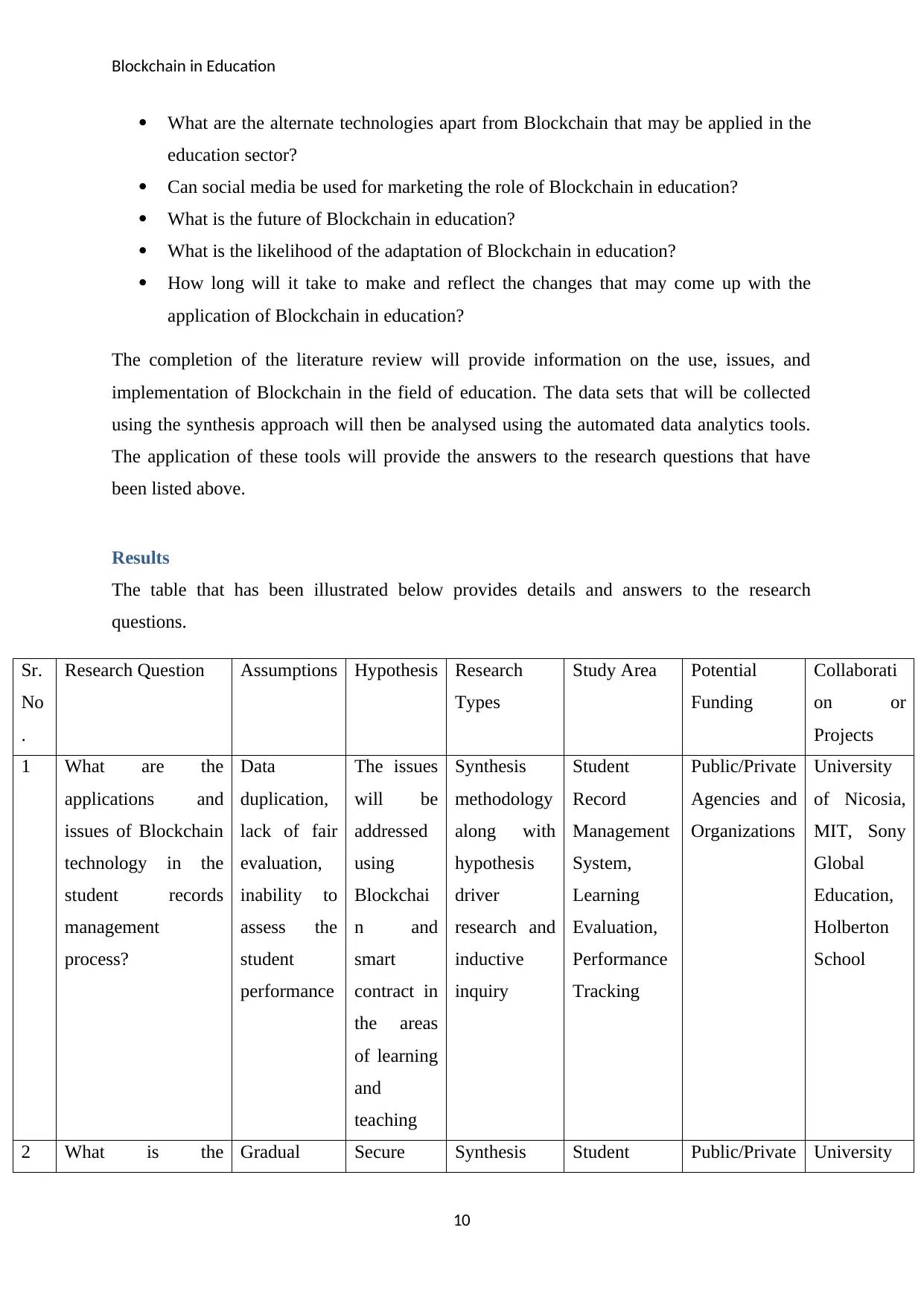
Blockchain in Education
What are the alternate technologies apart from Blockchain that may be applied in the
education sector?
Can social media be used for marketing the role of Blockchain in education?
What is the future of Blockchain in education?
What is the likelihood of the adaptation of Blockchain in education?
How long will it take to make and reflect the changes that may come up with the
application of Blockchain in education?
The completion of the literature review will provide information on the use, issues, and
implementation of Blockchain in the field of education. The data sets that will be collected
using the synthesis approach will then be analysed using the automated data analytics tools.
The application of these tools will provide the answers to the research questions that have
been listed above.
Results
The table that has been illustrated below provides details and answers to the research
questions.
Sr.
No
.
Research Question Assumptions Hypothesis Research
Types
Study Area Potential
Funding
Collaborati
on or
Projects
1 What are the
applications and
issues of Blockchain
technology in the
student records
management
process?
Data
duplication,
lack of fair
evaluation,
inability to
assess the
student
performance
The issues
will be
addressed
using
Blockchai
n and
smart
contract in
the areas
of learning
and
teaching
Synthesis
methodology
along with
hypothesis
driver
research and
inductive
inquiry
Student
Record
Management
System,
Learning
Evaluation,
Performance
Tracking
Public/Private
Agencies and
Organizations
University
of Nicosia,
MIT, Sony
Global
Education,
Holberton
School
2 What is the Gradual Secure Synthesis Student Public/Private University
10
What are the alternate technologies apart from Blockchain that may be applied in the
education sector?
Can social media be used for marketing the role of Blockchain in education?
What is the future of Blockchain in education?
What is the likelihood of the adaptation of Blockchain in education?
How long will it take to make and reflect the changes that may come up with the
application of Blockchain in education?
The completion of the literature review will provide information on the use, issues, and
implementation of Blockchain in the field of education. The data sets that will be collected
using the synthesis approach will then be analysed using the automated data analytics tools.
The application of these tools will provide the answers to the research questions that have
been listed above.
Results
The table that has been illustrated below provides details and answers to the research
questions.
Sr.
No
.
Research Question Assumptions Hypothesis Research
Types
Study Area Potential
Funding
Collaborati
on or
Projects
1 What are the
applications and
issues of Blockchain
technology in the
student records
management
process?
Data
duplication,
lack of fair
evaluation,
inability to
assess the
student
performance
The issues
will be
addressed
using
Blockchai
n and
smart
contract in
the areas
of learning
and
teaching
Synthesis
methodology
along with
hypothesis
driver
research and
inductive
inquiry
Student
Record
Management
System,
Learning
Evaluation,
Performance
Tracking
Public/Private
Agencies and
Organizations
University
of Nicosia,
MIT, Sony
Global
Education,
Holberton
School
2 What is the Gradual Secure Synthesis Student Public/Private University
10
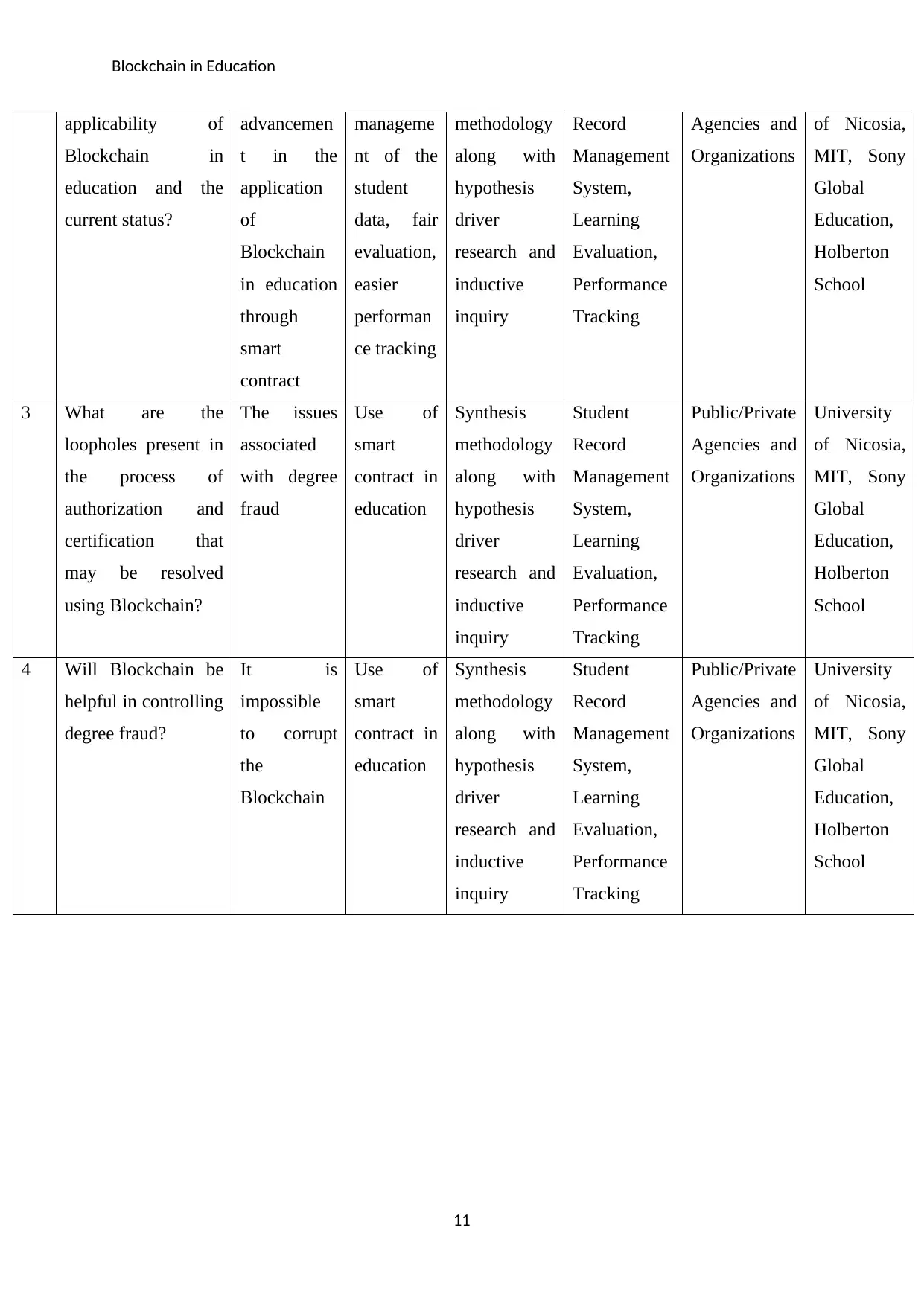
Blockchain in Education
applicability of
Blockchain in
education and the
current status?
advancemen
t in the
application
of
Blockchain
in education
through
smart
contract
manageme
nt of the
student
data, fair
evaluation,
easier
performan
ce tracking
methodology
along with
hypothesis
driver
research and
inductive
inquiry
Record
Management
System,
Learning
Evaluation,
Performance
Tracking
Agencies and
Organizations
of Nicosia,
MIT, Sony
Global
Education,
Holberton
School
3 What are the
loopholes present in
the process of
authorization and
certification that
may be resolved
using Blockchain?
The issues
associated
with degree
fraud
Use of
smart
contract in
education
Synthesis
methodology
along with
hypothesis
driver
research and
inductive
inquiry
Student
Record
Management
System,
Learning
Evaluation,
Performance
Tracking
Public/Private
Agencies and
Organizations
University
of Nicosia,
MIT, Sony
Global
Education,
Holberton
School
4 Will Blockchain be
helpful in controlling
degree fraud?
It is
impossible
to corrupt
the
Blockchain
Use of
smart
contract in
education
Synthesis
methodology
along with
hypothesis
driver
research and
inductive
inquiry
Student
Record
Management
System,
Learning
Evaluation,
Performance
Tracking
Public/Private
Agencies and
Organizations
University
of Nicosia,
MIT, Sony
Global
Education,
Holberton
School
11
applicability of
Blockchain in
education and the
current status?
advancemen
t in the
application
of
Blockchain
in education
through
smart
contract
manageme
nt of the
student
data, fair
evaluation,
easier
performan
ce tracking
methodology
along with
hypothesis
driver
research and
inductive
inquiry
Record
Management
System,
Learning
Evaluation,
Performance
Tracking
Agencies and
Organizations
of Nicosia,
MIT, Sony
Global
Education,
Holberton
School
3 What are the
loopholes present in
the process of
authorization and
certification that
may be resolved
using Blockchain?
The issues
associated
with degree
fraud
Use of
smart
contract in
education
Synthesis
methodology
along with
hypothesis
driver
research and
inductive
inquiry
Student
Record
Management
System,
Learning
Evaluation,
Performance
Tracking
Public/Private
Agencies and
Organizations
University
of Nicosia,
MIT, Sony
Global
Education,
Holberton
School
4 Will Blockchain be
helpful in controlling
degree fraud?
It is
impossible
to corrupt
the
Blockchain
Use of
smart
contract in
education
Synthesis
methodology
along with
hypothesis
driver
research and
inductive
inquiry
Student
Record
Management
System,
Learning
Evaluation,
Performance
Tracking
Public/Private
Agencies and
Organizations
University
of Nicosia,
MIT, Sony
Global
Education,
Holberton
School
11
⊘ This is a preview!⊘
Do you want full access?
Subscribe today to unlock all pages.

Trusted by 1+ million students worldwide
1 out of 20
Related Documents
Your All-in-One AI-Powered Toolkit for Academic Success.
+13062052269
info@desklib.com
Available 24*7 on WhatsApp / Email
![[object Object]](/_next/static/media/star-bottom.7253800d.svg)
Unlock your academic potential
Copyright © 2020–2025 A2Z Services. All Rights Reserved. Developed and managed by ZUCOL.





